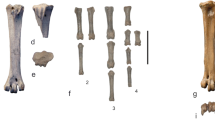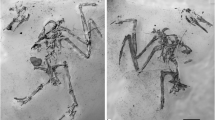Abstract
We describe new specimens of stem group representatives of Trochilidae (hummingbirds) and Todidae (todies) from the Rupelian of Frauenweiler in southern Germany. The hummingbird fossil constitutes the fourth record of Eurotrochilus inexpectatus. It consists only of wing and pectoral girdle elements, but shows the previously unknown crista deltopectoralis of the humerus, whose shape differs from modern hummingbirds. The carpometacarpus bears a well-developed processus intermetacarpalis, which is a further synapomorphy of Eurotrochilus and crown group Trochilidae. The disarticulated partial skeleton of the tody allows a definitive taxonomic assignment of the Frauenweiler species to Palaeotodus itardiensis Mourer-Chauviré, and likewise exhibits so far unknown osteological details, including the morphologies of the quadrate and scapula. We further comment on the exceptional taphonomy and preservation of avian fossils from the Frauenweiler clay pit, where terrestrial birds are represented only by small to very small species, whose skeletons are always strongly disarticulated.
Kurzfassung
Wir beschreiben neue Exemplare von Stammgruppenvertretern der Trochilidae (Kolibris) und Todidae (Todis) aus dem Rupelton von Frauenweiler in Süddeutschland. Das Kolibrifossil ist der vierte Nachweis von Eurotrochilus inexpectatus. Es besteht nur aus Flügel- und Brustgürtelelementen, zeigt aber die bisher unbekannte Crista deltopectoralis des Humerus, deren Form sich von derjenigen moderner Kolibris unterscheidet. Der gut entwickelte Processus intermetacarpalis des Carpometacarpus stellt eine weitere Synapomorphie von Eurotrochilus und Kronengruppen-Trochilidae dar. Das disartikulierte Teilskelett des Todi erlaubt eine endgültige taxonomische Zuordnung der Frauenweiler-Art zu Palaeotodus itardiensis Mourer-Chauviré und weist ebenfalls bis jetzt unbekannte osteologische Details auf, einschließlich der Morphologien des Quadratums und der Scapula. Wir diskutieren darüber hinaus die ungewöhnliche Taphonomie und der Erhaltung der Vogelfossilien aus der Tongrube Frauenweiler, in welcher terrestrische Vögel nur durch kleine bis sehr kleine Arten repräsentiert sind, deren Skelette zudem immer stark zerfallen sind.




Similar content being viewed by others
References
Baumel, J.J., and L.M. Witmer. 1993. Osteologia. In Handbook of avian anatomy: Nomina Anatomica Avium, eds. J.J. Baumel, A.S. King, J.E. Breazile, H.E. Evans, and J.C. Vanden Berge. Publications of the Nuttall Ornithological Club 23: 45–132.
Bocheński, Z., and Z.M. Bocheński. 2008. An Old World hummingbird from the Oligocene: A new fossil from Polish Carpathians. Journal of Ornithology 149: 211–216.
Elzanowski, A., G.S. Paul, and T.A. Stidham. 2000. An avian quadrate from the late Cretaceous lance formation of Wyoming. Journal of Vertebrate Paleontology 20: 712–719.
Grimm, K.I., M.C. Grimm, A. Köthe, and T. Schindler. 2002. Der „Rupelton” (Rupelium, Oligozän) der Tongrube Bott-Eder bei Rauenberg (Oberrheingraben, Deutschland). Courier Forschungsinstitut Senckenberg 237: 229–253.
Karhu, A. 1988. Novoye semeystvo strizheobraznykh iz paleogena Yevropy [A new family of swift-like birds from the Paleogene of Europe]. Paleontologicheskii Zhurnal 3: 78–88.
Karhu, A. 1999. A new genus and species of the family Jungornithidae (Apodiformes) from the late Eocene of the Northern Caucasus, with comments on the ancestry of hummingbirds. In Avian paleontology at the close of the 20th century: Proceedings of the 4th International Meeting of the Society of Avian Paleontology and Evolution, Washington, D.C., 4–7 June 1996, ed. S.L. Olson. Smithsonian Contributions to Paleobiology 89: 207–216.
Legendre, S., and F. Lévêque. 1997. Etalonnage de l’échelle biochronologique mammalienne du Paléogène d’Europe occidentale: Vers une intégration à l’échelle globale. In Actes du Congrès BiochroM’97, eds. J.-P. Aguilar, S. Legendre, and J. Michaux. Mémoires et Travaux de l’Ecole Pratique des Hautes Etudes, Institut de Montpellier 21: 461–473.
Louchart, A., N. Tourment, J. Carrier, T. Roux, and C. Mourer-Chauviré. 2008. Hummingbird with modern feathering: an exceptionally well-preserved Oligocene fossil from southern France. Naturwissenschaften 95: 171–175.
Mayr, G. 1998. “Coraciiforme” und “piciforme” Kleinvögel aus dem Mittel-Eozän der Grube Messel (Hessen, Deutschland). Courier Forschungsinstitut Senckenberg 205: 1–101.
Mayr, G. 2000. A new mousebird (Coliiformes: Coliidae) from the Oligocene of Germany. Journal für Ornithologie 141: 85–92.
Mayr, G. 2004a. A partial skeleton of a new fossil loon (Aves, Gaviiformes) from the early Oligocene of Germany with preserved stomach content. Journal of Ornithology 145: 281–286.
Mayr, G. 2004b. Old World fossil record of modern-type hummingbirds. Science 304: 861–864.
Mayr, G. 2005a. New trogons from the early tertiary of Germany. Ibis 147: 512–518.
Mayr, G. 2005b. A tiny barbet-like bird from the lower Oligocene of Germany: The smallest species and earliest substantial fossil record of the Pici (woodpeckers and allies). The Auk 122: 1055–1063.
Mayr, G. 2006. First fossil skull of a Paleogene representative of the Pici (woodpeckers and allies) and its evolutionary implications. Ibis 148: 824–827.
Mayr, G. 2007. New specimens of the early Oligocene Old World hummingbird Eurotrochilus inexpectatus. Journal of Ornithology 148: 105–111.
Mayr, G. 2009a. Notes on the osteology and phylogenetic affinities of the Oligocene Diomedeoididae (Aves, Procellariiformes). Fossil Record 12: 133–140.
Mayr, G. 2009b. Paleogene fossil birds. Berlin: Springer.
Mayr, G., and C. Knopf. 2007a. A stem lineage representative of buttonquails from the lower Oligocene of Germany—fossil evidence for a charadriiform origin of the Turnicidae. Ibis 149: 774–782.
Mayr, G., and C. Knopf. 2007b. A tody (Alcediniformes, Todidae) from the lower Oligocene of Germany. The Auk 124: 1294–1304.
Mayr, G., and A. Manegold. 2004. The oldest European fossil songbird from the early Oligocene of Germany. Naturwissenschaften 91: 173–177.
Mayr, G., and A. Manegold. 2006. New specimens of the earliest European passeriform bird. Acta Palaeontologica Polonica 51: 315–323.
Mayr, G., D.S. Peters, and S. Rietschel. 2002. Petrel-like birds with a peculiar foot morphology from the Oligocene of Germany and Belgium (Aves: Procellariiformes). Journal of Vertebrate Paleontology 22: 667–676.
Micklich, N. 1998. New information on the fish fauna of the Frauenweiler fossil site. Italian Journal of Zoology 65(supplement): 169–184.
Micklich, N., and L. Hildebrandt. 2005. The Frauenweiler clay pit (“Grube Unterfeld”). Kaupia: Darmstädter Beiträge zur Naturkunde 14: 113–118.
Micklich, N., and N. Parin. 1996. The fishfauna of Frauenweiler (Middle Oligocene, Rupelian; Germany): First results of a review. Instituto Español de Oceanografía, Publicaciones Especiales 21: 129–148.
Micklich, N.R., J.C. Tyler, G.D. Johnson, E. Świdnicka, and A.F. Bannikov. 2009. First fossil records of the tholichthys larval stage of butterfly fishes (Perciformes, Chaetodontidae), from the Oligocene of Europe. Paläontologische Zeitschrift 83: 479–497.
Monninger, S., and E. Frey. 2009. Oligocene bats from the clay pits around Frauenweiler. In 7th annual EAVP meeting 2009, abstract volume, eds. D. Schwarz-Wings, O. Wings, and F. Sattler. Aachen: Shaker.
Mourer-Chauviré, C. 1985. Les Todidae (Aves, Coraciiformes) des Phosphorites du Quercy (France). Proceedings of the Koninklijke Nederlandse Akademie van Wetenschappen, Series B 88: 407–414.
Mourer-Chauviré, C. 1995. Dynamics of the avifauna during the Paleogene and the early Neogene of France. Settling of the recent fauna. Acta zoologica cracoviensia 38: 325–342.
Olson, S.L. 1976. Oligocene fossils bearing on the origins of the Todidae and the Momotidae (Aves: Coraciiformes). Smithsonian Contributions to Paleobiology 27: 111–119.
Acknowledgments
We thank Harald and Annette Oechsler for donating the Eurotrochilus specimen to SMNK, and Klaus Weiß for the excellent preparation of both fossils—without their tireless enthusiasm many of the Frauenweiler fossils would not have been unearthed. We further thank Dino Frey for the loan of the Eurotrochilus specimen, and Sven Tränkner for taking the photographs. Ludwig Hildebrandt made the new profilings, which established the base for a precise stratigraphic allocation of the fossils. Recent excavations in the Frauenweiler fossil site were funded by the National Geographic Society (8553-08). The comments of two anonymous reviewers improved the manuscript.
Author information
Authors and Affiliations
Corresponding author
Rights and permissions
About this article
Cite this article
Mayr, G., Micklich, N. New specimens of the avian taxa Eurotrochilus (Trochilidae) and Palaeotodus (Todidae) from the early Oligocene of Germany. Paläontol Z 84, 387–395 (2010). https://doi.org/10.1007/s12542-009-0047-z
Received:
Accepted:
Published:
Issue Date:
DOI: https://doi.org/10.1007/s12542-009-0047-z




